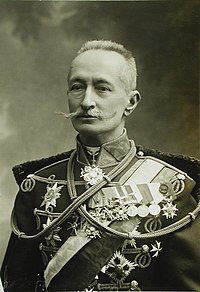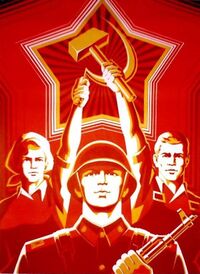Tretyakism: Difference between revisions
| Line 33: | Line 33: | ||
Whereas many nations that allow the ownership of firearms only permit individuals to purchase firearms, the Chistovodian government provided every citizen over the age of eighteen with a {{wp|Mosin-Nagant|firearm}} upon the passage of the 'Directive to Arm the Population'. Each rifle was given a serial number and a bureau within the Ministry of Defence catalogued to whom each rifle was assigned to. Alongside the delivery of these rifles were 60 rounds of ammunition. It was stipulated that in the event of an invasion, more ammunition would be delivered -- but until then, it was up to the citizen to purchase their own ammo. | Whereas many nations that allow the ownership of firearms only permit individuals to purchase firearms, the Chistovodian government provided every citizen over the age of eighteen with a {{wp|Mosin-Nagant|firearm}} upon the passage of the 'Directive to Arm the Population'. Each rifle was given a serial number and a bureau within the Ministry of Defence catalogued to whom each rifle was assigned to. Alongside the delivery of these rifles were 60 rounds of ammunition. It was stipulated that in the event of an invasion, more ammunition would be delivered -- but until then, it was up to the citizen to purchase their own ammo. | ||
[[File:TheSoldierWorker.jpg|200px|thumb|left]] | [[File:TheSoldierWorker.jpg|200px|thumb|left|Depicted alongside the traditional 'working classes'; the labourer and the agrarian, the soldier-worker became a common piece of Chistovodian propaganda.]] | ||
=== The Soldier Worker === | === The Soldier Worker === | ||
Revision as of 20:45, 5 February 2022
Tretyakism is the means of governing society and implementing social and economic policies which were either implemented or attempted to be implemented in Chistovodia during the years of 1949 - 1964. Though instituted by the Chistovodian General Congress of the time, its name is derived from General Kostyantyn Tretyak -- the leader of the revolutionary forces during the Chistovodian Civil War.
Tretyakism was implemented under the joint plans of President Eduard Bojchenko and Premier Kazymyr Shostak, both of them staunchly of the belief that the workers' revolution was an international armed struggle that should be continuously fought at all opportunities. Bojchenko and Shostak were both of the belief that councilism in the Asterias was under an existential threat of reprisal from the victorious powers of the Great War; who had been given enough time to regroup and consolidate themselves. Unsuccessful councilist uprisings in Asteria Inferior, and the subsequent tension between the Vinalias, led to the development of an ideology that sought to prepare Chistovodia to fight 'an entire continent of enemies', by arming its population and gearing the socialist state to become 'an armed intermediary' before its own dissolution.
Bojchenko forcibly conscripted and armed the population, believing it to be a way to further the policies of 'Councilism in All Countries' whilst Shostak developed the concept of the 'soldier worker': a yet undescribed section of the proletariat that was prepared and willing to fight to overthrow the bourgeoise as his dedicated profession. Both oversaw the development of 'hierarchical command' with the Chistovodian Section of the Workers' International and the 'militarisation of socialism', as well as the pursuing of social policies that regimented daily life to mirror that of a military unit to shift the nation into phase of 'total conflict'.
Economically, Bojchenko oversaw the creation of numerous specialised Presidium positions for industrial expansion whilst Shostak redeveloped the ministry of agriculture by decree of the General Congress into complete state control, removing many of the local authorities that had been set up by the initial revolution. Through contacts in the AIS, foreign thinkers, strategists, economists and inventors were hired to help prepare for what was regarded to be an 'inevitability' of conflict.
History
Tretyak led the Workers' Revolutionary Army during the Chistovodian Civil War, to great success. Unlike many contemporary communalist revolutionaries at the time, the WRA was successful in assimilating many elements of the existing military structure. Babych had instituted policies that had decentralised the Chistovodian army, placing it under the control of regionalist commanders who's authority ranged from but a face for the President or quasi-governors for the sections they operated in. Tretyak had served in the Chistovodian army for much of his life and his defection was viewed as a great boost of popularity for the CSWI, and was fortunate to be in command of the most modernised elements of the Chistovodian forces at the time.
Much of the success of the WRA has been attributed to Tretyak; even by the CSWI itself. Whilst Tretyak never coined a terminology of 'Tretyakism', he did codify his own beliefs down in several journals during the war -- as well as in its aftermath. After denying an invitation to serve as the first President of the nation, he collected his thoughts in the 'Treatise of the Soldier Worker' where he outlined his beliefs in the necessity of the armed struggle, and the necessity of a yet classified strata of society that he called 'the soldier workers'.
Tretyakist Policies
Tretyakist policies are held to be an independent strand of thought amongst socialist thinkers, though some political commentators and politicians have argued that it is the 'logical conclusion' of the beliefs of council communism and revolutionary socialism in what it aims to achieve: the liberation of the working class through a prolonged armed struggle against capitalism.
The ideology was adopted simultaneously by both the Chistovodian executive and legislature with the elections of Eduard Bojchenko and Kazymyr Shostak as President and Premier, respectively. Both quickly made moves to neuter opposition within the CSWI by conducting a fear campaign against the looming threats of the 'internationalist bourgeois', a resurgence of 'functionalism in the Asterias' and the fact that Chistovodia 'stood along as a bastion of workers in the Asterias'. Ruslana Tymoshenko, widely regarded to have been the most moderate and most reformist member of the General Congress, and who led the like-minded market socialists, was quickly placed on trial for the crime of 'treason' and publicly executed three weeks after Bojchenko and Shostak came to power. The strand of the CSWI associated with market socialism was also quickly dissolved, alienated and its members killed, imprisoned or barred from office.
Following this decisive elimination, many sections and factions within the CSWI fell behind Shostak within the Congress; and began to implement policy and plans that would achieve the desires of the Tretyakist movement.
Armed Proletariat
In an address to the General Congress, Premier Shostak declared that "in all struggles, those who are better armed are those who win". This simple principle outlined the government's policy towards the notion of the armed struggle against the bourgeoise. Whilst many councilist nations were hesitant to the idea of the mass ownership of arms, the Chistovodian Section of the Workers' International had come to the conclusion that due to their position as a diplomatically and ideologically isolated nation, the regularities of councilist thought were not applicable.
Historically, the CSWI had a history of irregular combatants composed of the working classes as an important section of their military victories during the Chistovodian Civil War. It was here that Tretyak believed in the usage of what he said was "not necessarily conscription, but volunteering out of necessity". President Bojchenko took this line of thinking and put it into the first piece of legislation that would be tabled by the General Congress.
Whereas many nations that allow the ownership of firearms only permit individuals to purchase firearms, the Chistovodian government provided every citizen over the age of eighteen with a firearm upon the passage of the 'Directive to Arm the Population'. Each rifle was given a serial number and a bureau within the Ministry of Defence catalogued to whom each rifle was assigned to. Alongside the delivery of these rifles were 60 rounds of ammunition. It was stipulated that in the event of an invasion, more ammunition would be delivered -- but until then, it was up to the citizen to purchase their own ammo.



